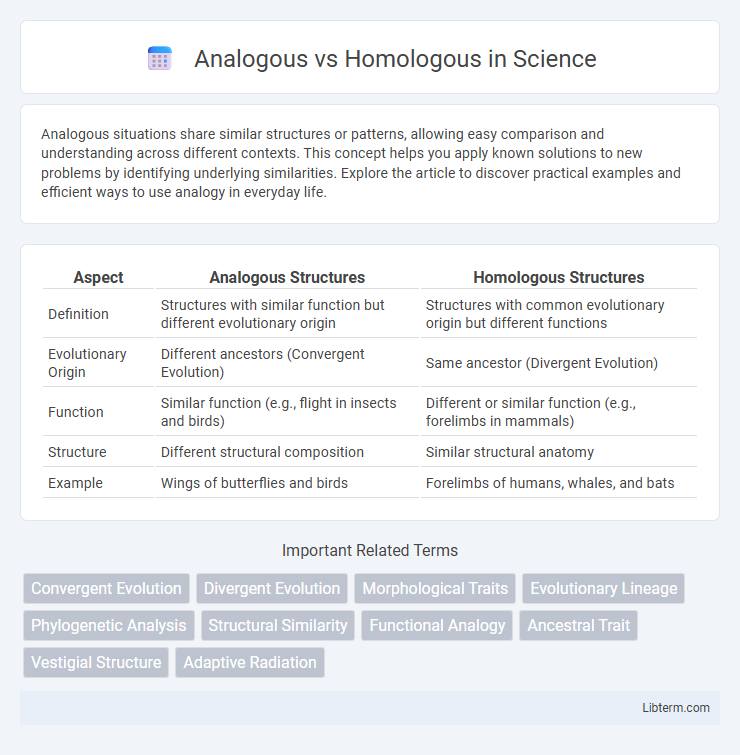Analogous situations share similar structures or patterns, allowing easy comparison and understanding across different contexts. This concept helps you apply known solutions to new problems by identifying underlying similarities. Explore the article to discover practical examples and efficient ways to use analogy in everyday life.
Table of Comparison
| Aspect | Analogous Structures | Homologous Structures |
|---|---|---|
| Definition | Structures with similar function but different evolutionary origin | Structures with common evolutionary origin but different functions |
| Evolutionary Origin | Different ancestors (Convergent Evolution) | Same ancestor (Divergent Evolution) |
| Function | Similar function (e.g., flight in insects and birds) | Different or similar function (e.g., forelimbs in mammals) |
| Structure | Different structural composition | Similar structural anatomy |
| Example | Wings of butterflies and birds | Forelimbs of humans, whales, and bats |
Introduction to Analogous and Homologous Structures
Analogous structures refer to body parts in different species that perform similar functions but do not share a common evolutionary origin, such as the wings of insects and birds. Homologous structures are anatomical features found in different species that arise from a common ancestor, despite potentially differing in function, like the limb bones of humans, whales, and bats. Understanding these distinctions helps clarify evolutionary relationships and adaptive strategies across diverse organisms.
Defining Analogous Structures
Analogous structures are anatomical features in different species that perform similar functions but do not share a common evolutionary origin, arising due to convergent evolution. These structures, such as the wings of insects and birds, exhibit functional similarity despite differing underlying anatomy and development pathways. Understanding analogous structures helps clarify functional adaptations separate from phylogenetic relationships.
Defining Homologous Structures
Homologous structures are anatomical features in different species that share a common evolutionary origin, despite possible differences in function or appearance. These structures arise from the same ancestral tissue and indicate divergent evolution, exemplified by the forelimbs of mammals like humans, whales, and bats. Homology provides critical evidence for evolutionary relationships, distinguishing it from analogous structures, which arise independently through convergent evolution.
Key Differences Between Analogous and Homologous
Analogous structures, such as the wings of insects and birds, perform similar functions but evolved independently without a common ancestor, reflecting convergent evolution. Homologous structures, like the forelimbs of humans, whales, and bats, share a common ancestral origin despite possibly differing functions, indicating divergent evolution. Key differences include evolutionary origin, structural similarity, and function, where homologous structures have similar anatomy due to shared ancestry, while analogous structures have different anatomy despite similar functionality.
Examples of Analogous Structures in Nature
Wings of butterflies and birds serve as prime examples of analogous structures, illustrating similar functions evolved independently in insects and vertebrates. The streamlined body shapes of sharks and dolphins represent another case of analogy, where fish and mammals adapt similar forms for efficient swimming despite different ancestries. Analogous structures reveal convergent evolution, highlighting functional adaptation rather than shared ancestry.
Examples of Homologous Structures in Evolution
Homologous structures in evolution demonstrate common ancestry through similar anatomical features, such as the forelimbs of humans, bats, whales, and cats, which share a common bone arrangement despite different functions. These structures highlight evolutionary adaptations, with variations in bone length and shape corresponding to specific environmental demands. The presence of homologous limbs across diverse species provides strong evidence for divergent evolution from a shared vertebrate ancestor.
Evolutionary Significance of Analogous Features
Analogous features arise from convergent evolution, where unrelated species develop similar traits independently due to comparable environmental pressures or ecological functions, illustrating adaptive solutions rather than common ancestry. These features highlight evolutionary innovation and functional adaptation rather than genetic lineage, contrasting with homologous structures that indicate shared evolutionary origins. Understanding analogous traits emphasizes the diversity of evolutionary pathways and the role of natural selection in shaping organisms to fit their habitats.
Evolutionary Significance of Homologous Features
Homologous features demonstrate common ancestry by exhibiting similar anatomical structures despite different functions, highlighting evolutionary relationships among species. These traits provide critical evidence for divergent evolution, where species evolve from a shared ancestor and adapt to various environments. Understanding homologous structures allows scientists to reconstruct phylogenetic trees and trace evolutionary lineages accurately.
Comparative Analysis: Analogous vs Homologous
Analogous structures arise from convergent evolution, where different species develop similar traits independently to adapt to comparable environments, such as wings in insects and birds. Homologous structures, in contrast, originate from a common ancestor, exhibiting similar anatomical features despite potential functional differences, exemplified by the forelimbs of mammals like humans, whales, and bats. This comparative analysis highlights the distinction between evolutionary pathways: analogous traits reflect functional similarity without shared ancestry, whereas homologous traits indicate evolutionary lineage with possible divergent functions.
Conclusion: Importance in Evolutionary Biology
Analogous structures highlight convergent evolution, showing how different species independently develop similar traits to adapt to similar environments. Homologous structures reveal common ancestry, providing crucial evidence for evolutionary relationships among species. Understanding both types of structures is essential for reconstructing evolutionary history and clarifying adaptive processes in biology.
Analogous Infographic

 libterm.com
libterm.com